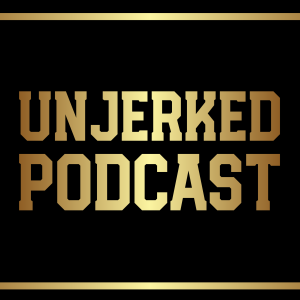Unjerked Podcast
We are Unjerked - the podcast aimed at fighting echo chambers in a fun way. We are affiliated with jabde.com - a purposely fake satire website which publishes fake academic journal articles. We thought it would be a great idea to create an inverse platform, which focuses on finding the truth behind ”common knowledge” found on websites like Reddit or Twitter. We will do the best we can to focus on academic research as the basis for our podcast, along with other reputable sources. We’ll probably start out as a semi-monthly podcast, and see how things go. Stay tuned for more!
Episodes

2 days ago

Friday May 02, 2025
Friday May 02, 2025
Summary
William Henderson and B. McGraw discuss U.S. agriculture subsidies—what they are, how they work, and the tradeoffs they create. The conversation covers the history and structure of these subsidies, as well as political and economic consequences.
Agriculture Policy
We begin by examining the political durability of subsidies, driven in part by the disproportionate influence of rural states in the Senate. Despite the shrinking number of farmers, these programs remain deeply entrenched.
Next, we look at who benefits—mainly large agribusinesses—and contrast supply-side subsidies with programs like SNAP. We then explore New Zealand’s decision to eliminate subsidies in the 1980s, which led to higher productivity and stable employment.
We also consider national security arguments for supporting domestic food production, as well as the impact of consolidation, automation, and contract farming on labor and ownership.
Later, we question whether private markets (futures, insurance) could manage agricultural risk without government support. This leads into a discussion of grocery prices, inflation, and whether “greedflation” or broader economic forces are driving costs.
Finally, we touch on the unintended effects of subsidies on public health and the environment—like their contribution to obesity and monoculture farming—and explore climate policy, water use, and immigration’s role in farm labor.
The episode closes with a look at whether the current system is effective policy—or simply politically untouchable.
Timestamps
00:00 — Intro and political feasibility of removing subsidies
01:56 — Distributive effects and difficulty of reform
02:39 — Comparison to New Zealand’s reforms
03:03 — National security as justification
06:16 — Industrial consolidation and automation
04:20 — New Zealand outcomes and productivityCato Institute on NZ Reform
06:00 — Market price stability and crop insurance
7:44 — High prices and greedflation
09:27 — Inflation and COVID supply shocks
10:12 — National security and industrial policy
13:07 — Obesity and health outcomes
14:56 — Conspiracy theory
15:54 — Regenerative agriculture
21:52 — Environmental damage
23:58 — Subsidies and food prices
24:23 — Desert farms
27:47 — Immigration and labor supply issues
This is the unjerked podcast!

Monday Apr 14, 2025
Monday Apr 14, 2025
William Henderson and B. McGraw talk about agriculture policy. What kind of subsidies exist and why? This is part 1 of 2 episodes?
We first briefly discuss the different types of farming, to include a completely free-market farming, subsidized farming, and collectivized soviet-style farming. Then, we discuss the comparison of subsidy levels between different countries. New Zealand is the lowest with a near 0% level of agriculture subsidies. On the other hand, many countries with high levels of subsidies include Iceland, Japan, and Norway. We then go over an article which discusses New Zealand's decision to pull subsidies in the 1980s. This led to an increased efficiency in farm production and did not lead to reliance on imports for food.
After all of this, we go over the farm bill and similar policies which help shape the system of farm subsidies in the US. This includes price loss coverage and agricultural risk coverage, which help pay farmers if commodity prices get too low. Marketing assistance loans are similar and involve lending money when prices get low. Crop insurance helps cover for issues like severe weather, crop failure, etc. Various conservation programs incentivize the use of environmentally friendly practices.
We then talk about disaster assistance programs, specialty crop support programs, and biofuel programs.
4:20 collective farming
6:38 OECD white paper with country comparisons
9:57 CATO article on total subsidies
13:43 Farm bill (2) (3) (4) (5) (6) (7) (8) (9) (10) (11) (12) (13)
This is the Unjerked Podcast!

Monday Mar 31, 2025
Monday Mar 31, 2025
William Henderson and B. McGraw talk about public transportation. What forms of transit make the most sense? This is part 2 of 2 episodes.
We first discuss gas taxes, both at the federal and state level, and how these are used to fund highway maintenance. We then discuss rail funding, which lacks a dedicated trust fund and is more volatile in availability. Then we talk about factors which increase rail transit use demand, to include neighborhood density. We then discuss congrestion prices, and the role they plan in controlling externalities associated with driving. Similarly, we go over the topic of dynamic parking pricing, which helps adjust demand for street parking.
We go over whether or not adding extra lanes is an effective method of reducing traffic. Then, we talk about various methods to reduce traffic accidents, to include more mass transit use, bicycle lanes, and fewer "stroads". Then, we discuss potential technology innovations in transportation. Finally, we go over the conspiracy theory of "15 minute cities", and whether or not this is a fair argument against walkable cities. 1:30 gas taxes (2)
6:40 rail funding
12:47 density, transit, expenditures
bureacracy
culture
20:33 congestion pricing
24:25 dynamic parking pricing
28:00 adding lanes
31:43 traffic accidents (2) (3)
41:10 technology
46:11 conspiracies
This is the Unjerked Podcast!

Friday Mar 14, 2025
Friday Mar 14, 2025
William Henderson and B. McGraw talk about public transportation. What forms of transit make the most sense? This is part 1 of 2 episodes.
We first discuss the international perspective on transit. The US has less public transit usage compared to other peer developed countries, although even those countries do not have full public transit penetration. We then discuss the different approaches to rail use, to include government owned rails with private and public cars, fully private but highly regulated private rails, and private rails with public cars.
Then we discuss the issue with the speed of construction in the US. Afterwards, we talk about the different transportation methods which exist, and the pros and cons of each. These include auto, bus, light rail, heavy rail, high speed rail, monorail, flying, ferries, and more.. After this, we discuss the cost of these different methods, to include the externalized costs. Finally, we go over saftey, carbon emissions, and timeliness of different methods.
3:22 international perspective (2) (3)
12:03 Government vs private sector
17:41 Speed of construction
19:40 transportation methods
27:14 pros and cons of methods
29:24 Cost comparison of methods (2)
37:25 safety
41:09 carbon emissions
43:44 time
This is the Unjerked Podcast!

Thursday Feb 27, 2025
Thursday Feb 27, 2025
William Henderson and B. McGraw discuss welfare in the United States. What programs do we have? Is it beneficial for society on balance?
We first talk about an overview of the different types of programs. Most of the programs by dollar figure are focused on the elderly and on healthcare, with much less focused on other programs. These major programs include social security, medicare, and medicaid. After this we talk about the general best practices around welfare design, to include tapering the ending of benefits, avoiding eligibility cliffs, etc.
We then discuss the effects of welfare on crime, to include lower crime rates tied to unemployment insurance. We then talk about the effect of universal healthcare in reducing per capital healthcare costs. After this we go over the effects of welfare on birth rates and family structure, effects on economic growth, and impacts on internal labor mobility. Then we go over issues like funding issues, fraud, gaps in the system, administrative inefficiencies, and more. We then go over some general questions and comments.
0:29 Disaster insurance
3:00 Old age programs
3:13 Poverty programs
5:43 Welfare design
9:33 Welfare and crime
10:21 Healthcare cost vs output (2) (3)
11:14 Economic effects
14:12 Birth rate / family structure (2) (3)
19:26 Effect on economic growth?
19:49 Internal labor mobility?
21:50 Funding issues
22:47 Fraud
23:41 Gaps in system
24:55 Inefficiencies
26:35 Editorializing
30:03 Comments
This is the Unjerked Podcast!
Additional Information:
CHIP
Head Start
LIHEAP
MedicareMedicaid
Pell GrantsSocial Security
SNAP
SSI
SSDI
TANF
Unemployment Insurance
VA Benefits (2) (3)
WIC
Overall Stats (2)

Thursday Feb 13, 2025
Thursday Feb 13, 2025
William Henderson and B. McGraw discuss welfare in the United States. What programs do we have? Is it beneficial for society on balance?
We first discuss the different types of systems which existed before government furnished aid. This includes religious charities, family networks, and more. Then we talk about the origins of state-based social programs, to include the English poor laws, as well as the New Deal in the United States. We then discuss government vs localized charity, and the pros and cons of each. We discuss the economic benefits of social programs, to include increased productivity of people who are given a path back to employment. Then we go over the founding fathers' views on welfare - to include Thomas Paine. Then, we discuss libertarian views on the topic, such as by F.A. Hayek and Milton Friedman. Finally, we discuss the origins of anti-welfare ideology, which traces its origins partly to social darwinism.
3:19 Pre-government welfare
6:02 English poor laws
7:12 New deal
7:50 Governmental vs local welfare
9:10 Religious origin
9:23 Productivity
11:23 Founding father
13:00 Thomas Paine
14:20 Adam Smith
15:07 Libertarianism
16:19 FA Hayek
17:35 Social darwinism
22:09 Marxist argument
23:25 Country comparisons
27:50 Types of welfare
31:29 Comments
This is the Unjerked Podcast!

Thursday Jan 16, 2025
Thursday Jan 16, 2025
William Henderson and B. McGraw talk about taxes in the United States. Why do we have them? What are the different types of taxes? What are the best tax policies? This is part 2 of 2 episodes.
We discuss the tax rate of different income quintiles, both before and after transfer payments. We then discuss the net fiscal contribution each US state makes to the federal government. Next, we go over the tax rates at which government revenue is maximized, as well as the tax rates which maximize GDP growth. Next, we go over ways in which wealthier people evade taxes. We discuss the conceptual framework of corporate vs individual income vs capital gains tax. Wealthier people often avoid capital gains tax by borrowing money using stock as collateral.
We discuss several reform ideas, to include transitioning from a sales tax to a VAT tax, transitioning from property tax to land tax, closing loopholes, and finding better ways to tax capital gains (to include removing step up cost basis).0:56 Tax rates before and after transfers
3:00 State net contribution
8:55 Revenue maximizing tax rate
10:33 Revenue maximizes capital gains tax rate
11:25 GDP growth maximization (Pg 12-14) (2)
14:48 Why wealthy can pay lower taxes (1) (2) (3)
18:05 Corporate tax avoidance
19:12 Capital gains tax
20:30 Real estate
22:13 Reform ideas (1) (2) (3) (4) (5)
23:54 VAT tax
26:33 land tax (1) (2) (3)
This is the Unjerked Podcast!

Friday Jan 10, 2025
Friday Jan 10, 2025
William Henderson and B. McGraw talk about taxes in the United States. Why do we have them? What are the different types of taxes? What are the best tax policies? This is part 1 of 2 episodes.
First we talk about the reason why taxes exist and an international comparison of rates. Then, we talk about trends in federal rates over time. During the 19th century, the US had an extremely low rate, consisting mostly of tariffs. This changed with the introduction of the amendment allowing for a national income tax, with additional increases during the New Deal era. Interestingly, a much larger percentage were paid by high income earners and by corporations. Over time, this has shifted more towards a higher share being funded through payroll taxes and by lower income earners.
We then talk about the various federal taxes in the United States, to include the income, payroll, excise, capital gains, estate, and more. Finally, we discuss some of the state taxes which exist, and what those rates look like. Overall, there is no clear trend in terms of which states have higher rates than others. Oftentimes, when a state has a lower rate in a certain category (e.g. property), they will have a higher rate in another (e.g. income).
2:22 Intro
3:45 Why taxes exist
11:06 Public goods
11:23 Wealth redistribution?
12:13 International comparison
13:30 Global corporate tax
15:36 Federal tax over time
16:07 shift in percentage types of tax (tariff, etc) (2)
19:15 effective rates by income (2)
23:02 Actual effective tax rate in the 1950s
24:38 Deadweight loss vs social services
28:10 Federal tax types (1) (2) (3) (4) (5) (6) (7) (8) (9) (10) (11) (12) (13) (14)
32:37 State taxes (1) (2) (3) (4)
This is the Unjerked Podcast?

Thursday Jan 02, 2025
Thursday Jan 02, 2025
William Henderson and B. McGraw talk about prisons in the United States. Why are so many people in prison? What are some resolutions to this? This is Part 2 of 2 episodes.
We first start going over the various actual causes of the incarceration problem in the US. This mostly revolves around tough on crime legislation, to include three strike laws, mandatory minimums, and strict probation and parole violation punishments. Interestingly, the research tends to suggest these policies also do not decrease the crime rate.
We then talk about racial dynamics, to include disparities in arrest vs incarceration rates. Then we go over recidivism by type of crime. Following this, we go over the various mental health conditions which disproportionately affect incarcerated individuals, to include mood disorders and schizophrenia. Then we look at the correlation between personality disorders and incarceration. Finally, we talk about some reform ideas, to include better social support programs which reduce crime rates, less severe punishments for minor parole and probation violations, replacing short prison stays with community service or house arrest, replacing cash-bail with risk-based bail decisions, reducing private prisons, etc.
0:29 Public safety
2:45 Three strikes laws
5:30 mandatory minimums (2)
6:52 Probation
8:07 Racial dynamics (2) (3) (4)
11:11 Rate of being pulled over during the day and at night by race
12:15 Recidivism
12:47 Mental health and crime (1) (2) (3) (4) (5) (6) (7) (8)
17:18 Dark triad (2)
19:38 NPD (2)
20:32 Cluster A/B/C disorders (1) (2) (3) (4) (5) (6)
26:10 reform ideas










